Before one of H.S. Arun’s classes in this past weekend’s workshop, he mentioned that Sukhasana (happy pose) and Svastikasana (cross pose) were different poses when instructing a student about another topic. Another student asked him “you mean ‘firelog’ pose? He laughed and said “there is no such thing as a firelog pose, that’s made up.” I asked him, “what is the difference between Sukhasana and Svastikasana?” He said “it’s in the feet,” and then moved on without explanation.
In the next day’s class, he built a whole sequence around the two poses. The short of it is that in Sukhasana the feet are passive, in Svasktikasana the feet are active. But there is much more to the story than that.
Student Chris was gracious enough to model these to poses after class today. Here is Sukhasana:
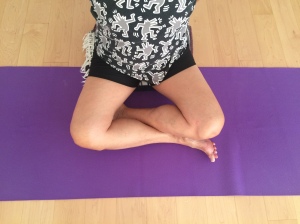
From this angle you see that the feet are passive. From this next angle you see what happens to the spine.
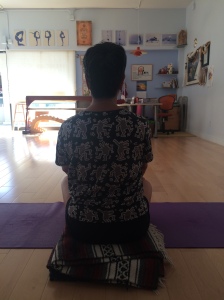
Her left knee is slightly higher than her right which causes a subtle curve in the spine, or as Arun said “it looks like the student has scoliosis.”
Now here is Svastikasana:
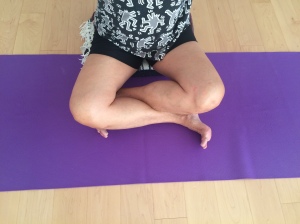
You can see the feet are now active. That gives this corresponding effect to the spine:
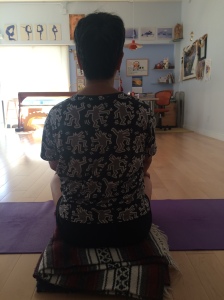
You can see that her knees are now even and her spine is correspondingly straighter.
So should we throw out Sukhasna because it is not as symmetrical? Of course not. One of Sukhasna’s great features is that it is passive, unlike Svastikasana. That makes it more appropriate for chanting the invocation to Patanajali, or reciting mantras as there is a receptive element to the pose.
On a side note, Svasti, or Swasti denotes “well being” in Sanskrit. Unfortunately, the symbol of Swasti was stolen and used as a symbol of hatred, whereas before it was a sacred symbol of both Asian Indian and Native American cultures.
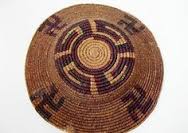
Definitely not firelog pose!


Thank you for a wonderful pot. This is sooo interesting – and the photos are great (thank you – and to your model).
I love the idea of ‘passive feet’ increasing one’s state receiving in meditation/chanting.
LikeLiked by 2 people
Thanks bc!
LikeLiked by 1 person
Thanks very much for sharing this interesting explanation from HS Arun. Its been my understanding that for those with stiff hips Sukhasana is easier, its also easier on the feet I think
LikeLike
I like how he waited to answer the question in full until he could build it into a class. That is thoughtful teaching.
LikeLiked by 1 person
Thank you for your reply. Arun’s teaching was very deliberate. It was the sincerest answer to my question. I only hope to one day teach that well.
LikeLike
This very question came up for me at a workshop with Sue Scott a couple of weekends ago. She also explained that Sukhasana can be/is used as a preparatory pose for Padmasana whereas Svastikasana helps with poses like Ardha Matsyendrasana.
LikeLiked by 1 person
Fantastic post and as per your typical style of writing, quite succinct and easy to digest. I’m not sure I can really see a difference in her spine or an adjustment to her left knee – as with anything else, the real benefits of yoga are experiential and so I’ll be investigating this on my own. 🙂
I’m very curious… Can you point me toward a good, accurate, invocation for Patanjali? Have you posted it here somewhere?
LikeLiked by 1 person
Thank you for your comments 🙂 It is hard to see her spine, but I hope to inspire people to try the two variations to see for themselves. As far as Patanjali invocations, we Iyengar practitioners like Prashant Iyengar (Iyengar’s son) the best as that is our lineage even though BKS is in the picture, Prashant’s voice is the one chanting. https://www.youtube.com/watch?v=P7oOorSyfr4
Others I enjoy are Neel Kukarni’s version which sounds like Amazing Grace: https://www.youtube.com/watch?v=3fT_fTH-STw&list=PL90EE0E230C411237
And lastly Srivatsa Ramaswami, who studied with Krishnamacharya for 30 years as a beautiful chant here at (starting at 7:10 mark): https://www.youtube.com/watch?v=J7o1UxEVwgs
Hope you enjoy these as much as I have.
Many blessings 🙂
LikeLiked by 1 person